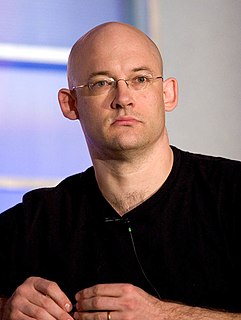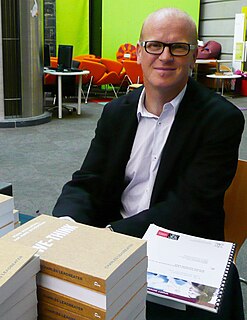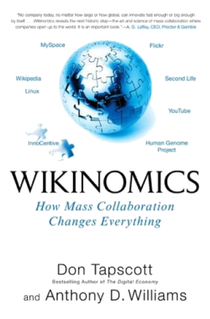"The Nature of the Firm" (1937) is an article by Ronald Coase. It offered an economic explanation of why individuals choose to form partnerships, companies and other business entities rather than trading bilaterally through contracts on a market. The author was awarded the Nobel Memorial Prize in Economic Sciences in 1991 in part due to this paper. Despite the honor, the paper was written when Coase was an undergraduate and he described it later in life as "little more than an undergraduate essay."

An organization, or organisation, is an entity—such as a company, an institution, or an association—comprising one or more people and having a particular purpose.
In economics and related disciplines, a transaction cost is a cost in making any economic trade when participating in a market. Oliver E. Williamson defines transaction costs as the costs of running an economic system of companies, and unlike production costs, decision-makers determine strategies of companies by measuring transaction costs and production costs. Transaction costs are the total costs of making a transaction, including the cost of planning, deciding, changing plans, resolving disputes, and after-sales. Therefore, the transaction cost is one of the most significant factors in business operation and management.
An online community, also called an internet community or web community, is a community whose members interact with each other primarily via the Internet. Members of the community usually share common interests. For many, online communities may feel like home, consisting of a "family of invisible friends". Additionally, these "friends" can be connected through gaming communities and gaming companies. Those who wish to be a part of an online community usually have to become a member via a specific site and thereby gain access to specific content or links.
Social software, also known as social apps, include communication and interactive tools often based on the Internet. Communication tools typically handle the capturing, storing and presentation of communication, usually written but increasingly including audio and video as well. Interactive tools handle mediated interactions between a pair or group of users. They focus on establishing and maintaining a connection among users, facilitating the mechanics of conversation and talk. Social software generally refers to software that makes collaborative behaviour, the organisation and moulding of communities, self-expression, social interaction and feedback possible for individuals. Another element of the existing definition of social software is that it allows for the structured mediation of opinion between people, in a centralized or self-regulating manner. The most improved area for social software is that Web 2.0 applications can all promote cooperation between people and the creation of online communities more than ever before.
In politics, emergent democracy represents the rise of political structures and behaviors without central planning and by the action of many individual participants, especially when mediated by the Internet. It has been likened to the democratic system of ancient Greece in the sense that people could publicly participate as much or as little as they please, although a form of representation exists which is based on personal trust networks instead of party affiliations. More recently, American writer and researcher Clay Shirky has referred to this as "the power of organizing without organizations."
In law and economics, the Coase theorem describes the economic efficiency of an economic allocation or outcome in the presence of externalities. The theorem states that if trade in an externality is possible and there are sufficiently low transaction costs, bargaining will lead to a Pareto efficient outcome regardless of the initial allocation of property. In practice, obstacles to bargaining or poorly defined property rights can prevent Coasean bargaining. This 'theorem' is commonly attributed to Nobel Prize winner Ronald Coase.
A Pigovian tax is a tax on any market activity that generates negative externalities. The tax is normally set by the government to correct an undesirable or inefficient market outcome, and does so by being set equal to the external marginal cost of the negative externalities. In the presence of negative externalities, social cost includes private cost and external cost caused by negative externalities. This means the social cost of a market activity is not covered by the private cost of the activity. In such a case, the market outcome is not efficient and may lead to over-consumption of the product. Often-cited examples of such negative externalities are environmental pollution, and increased public healthcare costs associated with tobacco and sugary drink consumption.

A collaboration tool helps people to collaborate. The purpose of a collaboration tool is to support a group of two or more individuals to accomplish a common goal or objective. Collaboration tools can be either of a non-technological nature such as paper, flipcharts, post-it notes or whiteboards. They can also include software tools and applications such as collaborative software.

An audience is a group of people who participate in a show or encounter a work of art, literature, theatre, music, video games, or academics in any medium. Audience members participate in different ways in different kinds of art; some events invite overt audience participation and others allowing only modest clapping and criticism and reception.

In statistics and business, a long tail of some distributions of numbers is the portion of the distribution having many occurrences far from the "head" or central part of the distribution. The distribution could involve popularities, random numbers of occurrences of events with various probabilities, etc. The term is often used loosely, with no definition or arbitrary definition, but precise definitions are possible.
The Problem of the Media: U.S. Communication Politics in the 21st Century is a book by Robert W. McChesney first published in 2004 by Monthly Review Press. The book discusses issues within journalism, as well as weaknesses in the media sector, and new ways to regulate such.

Clay Shirky is an American writer, consultant and teacher on the social and economic effects of Internet technologies and journalism.

Charles Leadbeater, also known as Charlie Leadbeater, is a British author and former advisor to Tony Blair.

Wikinomics: How Mass Collaboration Changes Everything is a book by Don Tapscott and Anthony D. Williams, first published in December 2006. It explores how some companies in the early 21st century have used mass collaboration and open-source technology, such as wikis, to be successful.

A civil society campaign is one that is intended to mobilize public support and use democratic tools such as lobbying in order to instigate social change. Civil society campaigns can seek local, national or international objectives. They can be run by dedicated single-issue groups such as Baby Milk Action, or by professional non-governmental organisations (NGOs), such as the World Development Movement, who may have several campaigns running at any one time. Larger coalition campaigns such as 2005's Make Poverty History may involve a combination of NGOs.
Social marketing intelligence is the method of extrapolating valuable information from social network interactions and data flows that can enable companies to launch new products and services into the market at greater speed and lower cost. This is an area of research however, companies using social marketing intelligence have achieved significant improvement in marketing campaigns.

Cognitive Surplus: How Technology Makes Consumers into Collaborators is a 2010 non-fiction book by Clay Shirky, originally published in with the subtitle "Creativity and Generosity in a Connected Age". The book is an indirect sequel to Shirky's Here Comes Everybody, which covered the impact of social media. Cognitive Surplus focuses on describing the free time that individuals have to engage with collaborative activities within new media. Shirky's text searches to prove that global transformation can come from individuals committing their time to active engagement with technology. Overall response has been mixed with some critics praising Shirky's insights but also decrying some of the shortcomings of his theory.
Networked advocacy or net-centric advocacy refers to a specific type of advocacy. While networked advocacy has existed for centuries, it has become significantly more efficacious in recent years due in large part to the widespread availability of the internet, mobile telephones, and related communications technologies that enable users to overcome the transaction costs of collective action.
Mass amateurization refers to the capabilities that new forms of media have given to non-professionals and the ways in which those non-professionals have applied those capabilities to solve problems that compete with the solutions offered by larger, professional institutions. Mass amateurization is most often associated with Web 2.0 technologies. These technologies include the rise of blogs and citizen journalism, photo and video-sharing services such as Flickr and YouTube, user-generated wikis like Wikipedia, and distributed accommodation services such as Airbnb. While the social web is not the only technology responsible for the rise of mass amateurization, Clay Shirky claims Web 2.0 has allowed amateurs to undertake increasingly complex tasks resulting in accomplishments that would seem daunting within the traditional institutional model.









